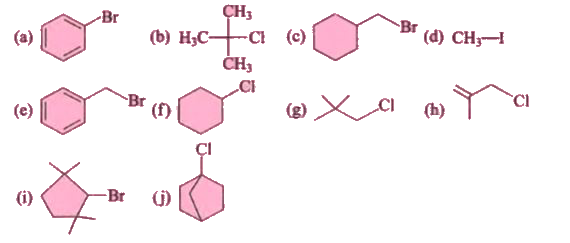Gem dihalides on treatment with alcoholic KOH give
Alkyne
Alkene
Alkane
All of these
The correct Answer is:A
To solve the question regarding the reaction of gem dihalides with alcoholic KOH, we can follow these steps:
1. Identify Gem Dihalides:
- Geminal dihalides (gem dihalides) are compounds that have two halogen atoms attached to the same carbon atom. An example is CH3CHBr2.
2. Understand the Reaction:
- When gem dihalides are treated with alcoholic KOH, they undergo a reaction known as dehydrohalogenation. This reaction involves the elimination of hydrogen halides (HX), where X is the halogen.
3. Write the Reaction:
- For the example CH3CHBr2, when treated with alcoholic KOH, the reaction can be represented as:
CH3CHBr2+KOHalcoholic−−−−−→CH≡C−H+2HBr
- Here, the two bromine atoms are eliminated along with two hydrogen atoms from adjacent carbons, leading to the formation of an alkyne.
4. Identify the Product:
- The product formed from the reaction is an alkyne. In this case, the product is acetylene (ethyne), represented as CH≡CH.
5. Conclusion:
- Therefore, the answer to the question is that gem dihalides on treatment with alcoholic KOH give an alkyne.
Final Answer:
Gem dihalides on treatment with alcoholic KOH give an alkyne.
---
- Geminal dihalides (gem dihalides) are compounds that have two halogen atoms attached to the same carbon atom. An example is CH3CHBr2.
- When gem dihalides are treated with alcoholic KOH, they undergo a reaction known as dehydrohalogenation. This reaction involves the elimination of hydrogen halides (HX), where X is the halogen.
- For the example CH3CHBr2, when treated with alcoholic KOH, the reaction can be represented as:
CH3CHBr2+KOHalcoholic−−−−−→CH≡C−H+2HBr
- Here, the two bromine atoms are eliminated along with two hydrogen atoms from adjacent carbons, leading to the formation of an alkyne.
- The product formed from the reaction is an alkyne. In this case, the product is acetylene (ethyne), represented as CH≡CH.
- Therefore, the answer to the question is that gem dihalides on treatment with alcoholic KOH give an alkyne.
Gem dihalides on treatment with alcoholic KOH give an alkyne.
Similar Questions
Knowledge Check
Bromoethane on treatment with alcoholic KOH gives
Aethyl alcoholBbutaneCmethaneDethyleneA mixture of 1−chloropropane and 2−chloropropane when treated with alcoholic KOH, it gives
Aprop-1-eneBprop-2-eneCa mixture of prop-1-ene and prop-2 eneDpropanol.
Ethylidene chloride on treatement with aq. KOH gives
View SolutionEthylidene chloride on treatement with aq. KOH gives
View SolutionExamine the ten structures shown below and select those that satisfy each of the following condition.

How many compounds give E2 reaction on treatment with alcoholic KOH?
View SolutionCompound X on treatment with HI give Y, Y on treatment with ethanolic KOH gives Z (an isomer of X). Ozonolysis of Z (with H2O2 workup) gives a two -carbon carboxylic acid and four carbon ketone . Hence, X is :
View SolutionAn organic compound (A) C4H9Cl on reacting with aqueous KOH gives (B) and on reaction with alcoholic KOH gives (C ), which is also formed on passing the vapours of (B) over the heated copper. The compound (C ) readily decolourises bromine water. Ozonolysis of (C ) gives two compounds (D) and (E ). Compound (D) reacts with NH2OH to give (F) and compound (E ) reacts with NaOH to have an alcohol (G) and sodium salt (H) of an acid. (D) can also be prepared form propyne on treatment with water in the presence of Hg2+ and H2SO4. Identify (A) to (H) with proper reasoning.
View Solution
Why does not (C) gives (D) or (D1) on treatment with alcoholic KOH or with C2H5ONa+C2H5OH?
View Solution
